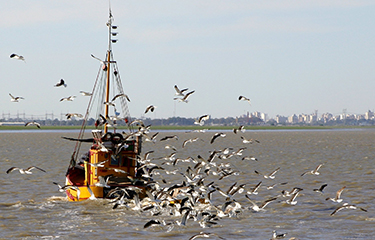The Argentine red shrimp fishery has moved closer to Marine Stewardship Council certification.
The country's institute of fisheries, INIDEP, has developed a limit reference point for shrimp stock – a point at which fishing is no longer considered sustainable. Below that point there is a higher probability the stock is impaired and will not be able to replenish itself. The move is a requirement for MSC certification.
In addition to the new limit point, Argentina's Federal Fisheries Council has implemented an abundance criterion when deciding to open and close zones. And Argentina's Undersecretary of Fishing, through its Control Directorate, has achieved total coverage in landing inspections, with about 6 percent presenting some type of infraction.
Through INIDEP’s Research Report 50/2022, the institute proposed an abundance reference point that is a trigger threshold, that once hit will cause implementation of immediate measures to reduce fishing efforts. Those reductions will be defined by the Federal Fisheries Council (CFP), and the contingency plan is still being discussed but will transform the reference point into specific measures to reduce fishing effort if that threshold is exceeded, according to CeDePesca Executive Director Ernesto Godelman. The reference point will consist of 60 percent of the average number of prawns surveyed during INIDEP’s March campaigns, where currently the stock is at 75 percent of the average numbers, he said.
The meeting included modifications to management measures of the resource, a capture by unit of effort (CPUE) criterion that aids in the decision-making on opening and closing zones to fishing. INIDEP made the recommendation to consider a different CPUE limit for each month, basing the numbers on historical data to avoid recruitment overfishing – when high exploitation rates reduce enough mature individuals that recruitment is reduced and may lead to stock collapse.
Though the overall stock abundance has decreased since its peak in 2017, it has not reached concerning levels yet. The INIDEP report emphasized the yield of the population has been maintained at “excellent levels, around 200,000 tons in recent years,” which was gathered from annual landing reports.
Therefore, recent news from the National Directorate for Fisheries Coordination and Control that 99 percent of shrimp landings were covered with inspections, demonstrates the ability of current fisheries authorities to ensure the sustainability sticks, Godelman said.
Lastly, in the province of Chubut, Argentina, fishing authorities met the requirements of the country's Resolution 6/2019 to open and close the fishing season based on technical reports that were provided in a timely manner.
These advances, the fact that shrimp stock is a shared resource between provincial and federal waters, and the INIDEP proposals and the CFP decisions to ensure sustainability, have increased the probability of obtaining the MSC certification for the province’s fishery, Godelman said.
Photo courtesy of Luis César Tejo/Shutterstock







